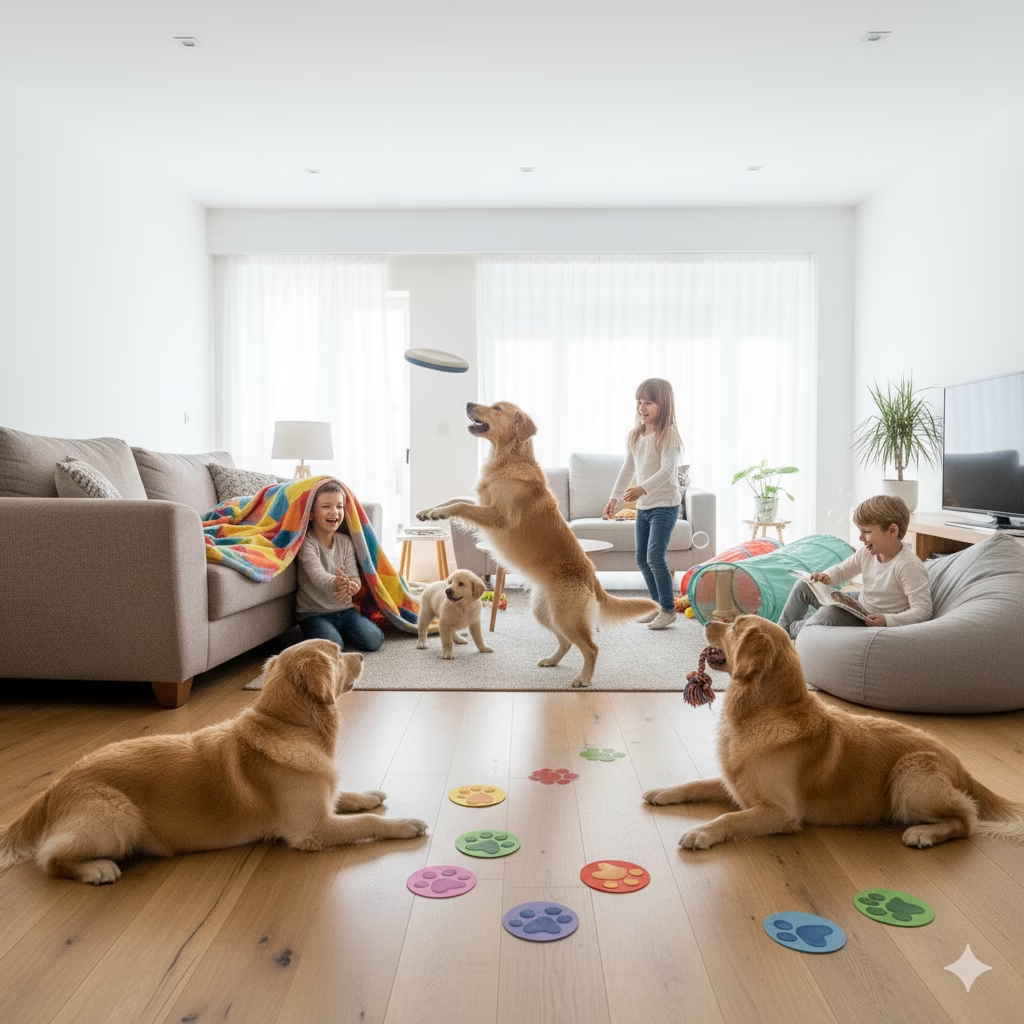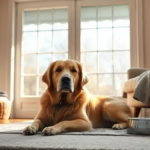The Rainy Day Dilemma: A Recipe for Cabin Fever
We’ve all been there. It’s pouring rain outside, the sky is a dreary shade of grey, and you’re stuck indoors. You have a child whose energy levels are inversely proportional to the falling barometer, and a young Golden Retriever who is practically bouncing off the walls with pent-up energy. It’s a classic recipe for cabin fever, where a peaceful home can quickly descend into a chaotic mess of zoomies, whining, and general frustration (from all species involved).
For a long time, I saw these days as something to simply survive. My goal was damage control. But then I had a shift in mindset. What if these moments weren’t an obstacle, but an opportunity? What if, instead of just trying to keep everyone from going stir-crazy, we could use this focused indoor time to build their bond, sharpen their minds, and have some genuine, joyful fun together?
That’s when I developed our “Rainy Day Playbook.” These aren’t just games to burn energy; they are carefully chosen activities designed to be safe for an indoor environment, mentally stimulating for a smart Golden, and incredibly engaging for a child. They are tools for teaching patience, teamwork, and problem-solving, disguised as pure fun. Here are the 10 games that have saved our sanity and strengthened my child’s bond with our dog, turning dreary days into some of our most cherished memories.
First, The Rules of Indoor Play
Before we start, it’s crucial to establish a few ground rules to ensure playtime is safe and constructive, not chaotic.
- Create a Safe Zone: We play these games in our largest open area (the living room) after pushing back the coffee table. Avoid slippery floors; if you have hardwood, lay down a large area rug or a few yoga mats to provide traction and prevent injuries.
- “Game On” and “Game Over”: We have clear signals for when playtime starts and ends. I’ll say “Ready to play?” in an excited voice. When we’re done, I’ll say “All done!” in a calm voice, and the special “game” toys are put away. This helps the dog learn to settle down when playtime is over.
- Human Toys Away: Before we start, my child’s job is to do a quick sweep and make sure all their own toys are put away. This prevents the dog from getting confused about what’s okay to grab.
Our Top 10 Indoor Games
1. The “Find It” Treasure Hunt (Nose Work 101)
This game is a fantastic way to engage a Golden’s most powerful tool: their nose. It’s calm, focused, and incredibly rewarding for them.
- How to Play: I have my child ask our dog, Finn, to “stay” in one room (or I’ll hold his collar). Then, we take a few small, smelly treats and “hide” them around the living room—behind a couch leg, under the edge of a rug, on a low bookshelf. We start very easy. Then we release him with an excited “Okay, find it!”
- The Kid’s Role: My son absolutely loves being the “Treasure Hider.” He also acts as the cheerleader, praising Finn excitedly every time he finds a treat. “Good boy, Finn! You found one!”
- Secret Benefit: This game builds a dog’s confidence and focus. It’s a low-impact mental workout that can be just as tiring as a long walk.
2. Puppy Hide-and-Seek
A classic childhood game that becomes ten times more fun with a dog. It’s also a brilliant way to practice the all-important “come” command.
- How to Play: One person (usually me) has Finn “stay” while my son runs off to hide. He doesn’t hide in a closet or anywhere too confined, but behind a couch or a door. Once he’s ready, he calls out “Ready!” and I release Finn with the cue, “Go find him!”
- The Kid’s Role: The hider! The payoff is the moment Finn discovers them, and they erupt in joyful praise and cuddles. It makes being found by the dog the biggest reward in the world.
- Safety Tip: Make sure the hiding spots are safe and that the child knows not to hide anywhere the dog could get stuck or knock something over.
3. The Magical Muffin Tin Puzzle
This is my go-to DIY food puzzle for mental stimulation. It takes two minutes to set up and keeps Finn engaged and thinking.
- How to Play: Take a standard muffin tin and place a few pieces of kibble or small treats in some of the cups. Then, cover all the cups with tennis balls or other dog-safe toys. Present the tin to your dog and let them figure out how to knock the balls away to get the treats.
- The Kid’s Role: My son is the “Puzzle Master.” He loves setting it up, deciding which cups get the treats, and placing the tennis balls on top.
- Secret Benefit: This is a fantastic problem-solving exercise that prevents boredom and encourages independent thinking.
4. Tug-of-War (With Rules!)
Tug is a wonderful game for Goldens, but it needs clear rules to keep it safe and prevent it from escalating into possessiveness.
- How to Play: We use a designated, long rope toy. The game is initiated by a human, not the dog. We engage in a gentle tug, with lots of happy, growly noises. The most important part is periodically saying “Drop it.” The moment Finn releases the toy, he gets a high-value treat. Then, the game can resume.
- The Kid’s Role: I always hold the main part of the tug toy, but my son can hold it with me. He is primarily in charge of saying “Drop it!” and providing the treat.
- Secret Benefit: This teaches crucial impulse control and reinforces the “drop it” command in a high-arousal situation. It also teaches that releasing a toy leads to rewards.
5. Hallway “Soft” Ball
Classic fetch is tough indoors, but a long hallway and a soft toy make it possible.
- How to Play: We use a lightweight, soft plush ball that won’t damage walls or furniture. My son sits at one end of the hall with Finn, and I sit at the other. He gently rolls or tosses the ball down the hall, Finn chases, and I encourage him to bring it back to my son.
- The Kid’s Role: The thrower and the receiver. This gives them a clear role and helps them practice a gentle throwing motion.
- Secret Benefit: It satisfies the Golden’s natural retrieving instinct in a controlled, safe environment.
6. “Which Hand?”
This is a simple, calm, close-contact scent game that’s perfect for winding down.
- How to Play: My son takes a small treat and shows it to Finn. He then puts his hands behind his back, conceals the treat in one fist, and presents both closed fists to Finn. He asks, “Which hand?” Finn has to sniff to figure out where the treat is. When he paws or nudges the correct hand, my son opens it and gives him the prize.
- The Kid’s Role: This is entirely a kid-led game. It teaches them to be still and let the dog use its brain.
- Secret Benefit: It’s a great focus-builder and reinforces a gentle interaction between child and dog.
7. Pet-Safe Bubble Chase
Pure, simple joy. This one is less about training and all about fun.
- How to Play: Buy a bottle of pet-safe, non-toxic bubbles (flavored ones like bacon or peanut butter are a huge hit). My son blows the bubbles, and Finn joyfully leaps and snaps at them.
- The Kid’s Role: The Bubble Master! What kid doesn’t love blowing bubbles?
- Safety Tip: Play on a non-slip surface as the floor can get a little wet, and limit sessions to 5-10 minutes to prevent them from ingesting too much of the bubble solution.
8. The Living Room Obstacle Course
Turn your living room into a canine agility course!
- How to Play: We use pillows to jump over (or walk around), a blanket draped over two chairs to create a tunnel, and a hula hoop to walk through. My son helps design the course and then uses a treat to lure Finn through each obstacle.
- The Kid’s Role: The Course Designer and the Guide. They love being in charge of the layout and leading Finn through their creation.
- Secret Benefit: This is a huge confidence builder for a dog, teaching them to navigate different objects and textures.
9. The “Clean Up Your Toys” Game
This is a game that’s also a life skill! It taps into a Golden’s desire to retrieve and hold things.
- How to Play: We started by teaching the “drop it” command over the toy basket. I’d hand Finn a toy, lead him to the basket, say “Drop it!” and reward him heavily when the toy fell in. Over time, it became a game. My son can now point to a toy on the floor and say “Put it away!” and Finn will retrieve it and drop it in the basket for a treat.
- The Kid’s Role: The Director. He points out the toys that need to be put away.
- Secret Benefit: It’s mentally stimulating, practical, and reinforces the idea that dog and child can work together as a team.
10. Puppy “Red Light, Green Light”
A fun spin on the classic game that is a powerhouse for teaching impulse control.
- How to Play: My son holds a treat. When he says “Green Light!” and starts walking backward, Finn is allowed to follow. When my son suddenly stops and says “Red Light!” Finn must stop (ideally, a sit). He only gets the treat when he holds his position until the next “Green Light” or an “All done!” cue.
- The Kid’s Role: The Traffic Controller. They are in complete control of the game’s pace.
- Secret Benefit: This is one of the best games for teaching a dog to pay close attention to verbal cues and body language, even when excited.
Conclusion: Turning Walls into a World of Fun
Being stuck indoors doesn’t have to mean being bored. For our family, it has become a special time to connect. These games have taught our dog valuable skills, but more importantly, they have taught my son how to be a patient teacher, a fun playmate, and a responsible leader. They have built a language of fun and trust between them that a simple walk around the block never could. So next time the clouds roll in, don’t just see a cancelled trip to the park. See an opportunity to build a world of adventure, right there in your living room.
A Real-Life Tip: Our absolute “emergency boredom buster” is a simple cardboard box. I take an old shipping box, put a few high-value, smelly treats inside, and loosely tape it shut. Then I give the whole box to Finn under supervision. The 15 minutes of pure joy he gets from shredding the cardboard to get his prize is unparalleled. My son calls it “Doggy Christmas” and loves to watch. It’s messy, but the mental and physical release it provides Finn is totally worth the cleanup.

Rafael Souza is a digital marketing strategist and lifelong dog enthusiast. Passionate about Golden Retrievers, he shares practical, research-based tips to help owners provide healthier and happier lives for their furry companions.





